|
It was hard to put down the bag of Apple Cinnamon Chicharrones (a.k.a. fried pork rinds, i.e., fried pork skin with the fat removed*) from Southern Recipes Small Batch. We had to call someone into our office to remove the bag before we polished it off.
Chicharrones (chee-cha-ROAN-ace—roll the double “r”) are a popular snack in many parts of the world. They’re often served alone like potato chips, but can also be eaten with sandwiches, salads, salsa, dips, and other foods.
High in protein and fat and low in carbs, they are popular on today’s keto and paleo diets.
Sweet, spicy, very crunchy and gluten-free, the snack food is a staple in:
Brazil (with feijoada, as a bar snack)
Colombia (with arepas and bandeja paisa)
Costa Rica (with boiled cassava, as a snack [often accompanied by lime, chimichurri, or chile Panamá hot sauce], a key ingredient in chifrijo: chicharrones, rice, and beans))
Cuba (with mojo sauce, tamales and other dishes)
Dominican Republic (as appetizers, snacks [often with lime wedges and hot sauce], with with tostones or plátanos fritos)
Mexico (tacos, gorditas, tortas, and for breakfast when served in salsa verde)
Peru (for breakfast with sweet potatoes and onions, with sandwiches)
Philippines (beer snack, often served with spiced vinegar dip)
Puerto Rico (with tostones and various traditional dishes)
Spain (tapas)
U.K. (pub snack)
U.S. (snacks, low-carb diets, gluten-free breading)
> See the different ways to use chicharrones, below.
Chicharrón is the singular form of the word; the plural, chicharrones, does not have an accent mark.
Chicharrones can be plain, seasoned with salt and pepper or spices. Plain chicharrones can be dipped in chocolate or dessert sauce (photo #5).
The second fall flavor from Southern Recipe, Cranberry Jalapeño, had a bit too much heat for us. Anyone who likes a kick of pepper at the back of the throat will enjoy them.
> The history of pork rinds is below.
> Here’s a recipe to make your own pork rinds.
> The different cuts of pork: a photo glossary.
> See the beer and pork rind flavor pairing chart below.
SOUTHERN RECIPE FLAVORS
Southern Recipe has an ample number of year-round pork rind flavors:
Basic flavors: Original, Bar-B-Que, Chili & Lime, Fire & Lime, Hot & Spicy
Specialty flavors: Hatch Chile, Hot Honey, Pasilla Chile Cheese, Pineapple Ancho Chile, Sea Salt & Cracked Black Pepper, Smoked Sea Salt, Spicy Dill
Cracklings: Original, Fire & Lime (cracklings are smaller, pieces that have the skin attached to the fat).
GET YOUR CHICHARRONES
Get Southern Recipe Small Batch Chicharrones from the company or at retailers nationwide.
> Here’s a store locator.
> Or, head to PorkRinds.com.
WAYS TO USE CHICHARRONES / PORK RINDS
In Costa Rica, chicharrones are a key ingredient in many traditional dishes, such as chifrijo and vigorones. Here are more ways to use them.
A snack or tapas with beer, wine, or other alcoholic beverages (photo #1).
A substitute for potato chips, tortilla chips, or pretzels (photo #6).
A different “chip” for dips, including guacamole, salsa, and queso.
A base for nachos.
Crumbled on toast, bread spreads, canapés.
With cheese spreads.
Topping/garnish for vegetable, grain, and noodle/pasta dishes (photo #7).
Salad “croutons.”
Crunch on sandwiches, burgers, and franks (photo #4).
Added to your favorite Chex Mix recipe.
Replacement for breading/bread crumbs on anything from chicken and meatloaf to mozzarella sticks (photo #8).
With soups and chili instead of crackers.
With Tex-Mex.
Tossed with cinnamon sugar for dessert with ice cream or coffee (photo #5).
Mix and match flavors with different styles of beers at a tasting party (photo #9).
Check out these chicharrón recipes from Southern Recipe.
More recipes with pork rinds.
THE HISTORY OF CHICHARRONES (PORK RINDS)
Chicharrón, fried pork rind (skin) or pork belly, was created as one way to utilize every part of the pig—nothing was wasted (an uncle from Sicily told us that they even ate the squeal, although in fact the kids fought over the crispy fried tail.
The dish originated in the area of Andalusia, Spain in pre-Hispanic times, which began in 38 B.C.E. It spread to Latin America in colonial times. From there it was a short hop to the U.S.
It was introduced to the Philippines during the Spanish colonization period, which began in 1565.
The word means “crackling,” from the Spanish verb “chicharrar,” meaning to fry until crispy.
The dish spread to Latin America during the colonial era, when pigs arrived in the New World with explorers and soldiers.
In Spain and Latin America chicharrones were made during matanzas (pig slaughters), typically in winter. The skin was cleaned, dried, and fried.
The process involves cooking pork skin until it puffs up and becomes crispy. The word “chicharrón” comes from Spanish, but the concept of fried pork skin appears in many cultures:
In Spain and Latin America: Traditional chicharrones were made during matanzas (pig slaughters), typically in winter. The skin was cleaned, dried, and fried.
In the American South, land of the barbecue, pork rinds gained popularity as a snack food during the early 20th century. Commercial production starting in the 1940s [source: Claude A.I.).
How Pork Rinds Became An American Snack
The evolution of chicharrones into modern snack foods is a story of industrialization and changing food habits.
In the early 1900s, chicharrones were still primarily made at home or by local butchers as part of traditional pork processing.
The transformation into a commercial snack food began in the 1940s-1950s, driven by several factors:
|
|
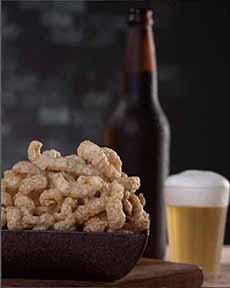
[1] A perfect snack with beer (all photos © Southern Recipe).
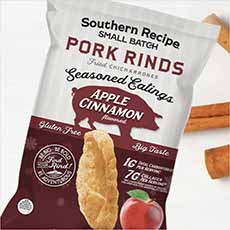
[2] Fall flavor #1: Apple Cinnamon chicharrones, sweet heat.
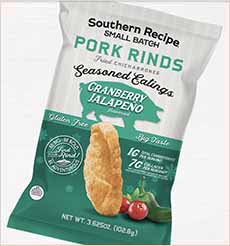
[3] Fall flavor #2: Cranberry Jalapeño, medium-hot.

[4] Crumble to garnish a hot dog, burger, salad, grains, rice, just about anything.
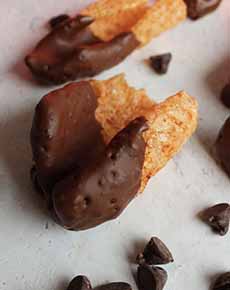
[5] Spicy chocolate-dipped pork rinds take just 10 minutes to make. Here’s the recipe. Another sweet treat: peanut butter chocolate pork rind bars.
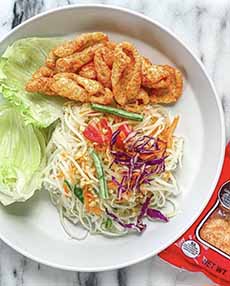
[6] Serve pork rinds in fusion cuisine, like these spicy Asian noodles, or with a sandwich instead of potato chips or tortilla chips.
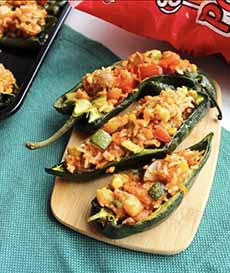
[7] In stuffed poblano chile peppers (here’s the recipe).
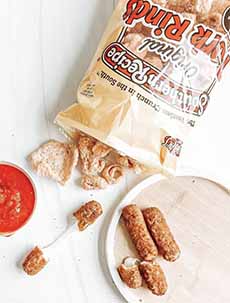
[8] As breading for mozzarella sticks (here’s the recipe).
|
|
Vacuum-sealed packaging technology allowed for longer shelf life.
Mechanized production lines could process large quantities of pork skin efficiently.
The postwar snacking boom of the 1950s and 1960s, and rise of convenience stores and vending machines.
Attracted customers beyond working-class consumers to those seeking a high-protein snack.
Attracted upscale consumers in the 1980s, as premium and artisanal versions emerged in gourmet food markets.
The appearance of the Atkins diet in the 1960s and the publication of Dr. Atkins’ New Diet Revolution in 2002.
Pork Rinds Today
New flavoring techniques introduced many flavor choices, like BBQ, dill, hot & spicy, salt & vinegar, and fancy flavors like Korean kimchi and pineapple ancho chile.
Microwave-ready raw pellets† allowed for home preparation from companies like Rudolph Foods, which has been selling pork rinds since 1955, and Carolina Gold Nuggets.
The keto and paleo diet trends boosted popularity as a zero-carb snack option.
Plant-based alternatives like Snacklins have appeared for vegetarian and vegan consumers.
Chicharrones can also be made from other meats, such as beef, chicken, or mutton. The preparation varies by region and country. In European Jewish cuisine, cracklings of chicken or goose fat—called gribenes or grieven, are served as a side with fried onions.
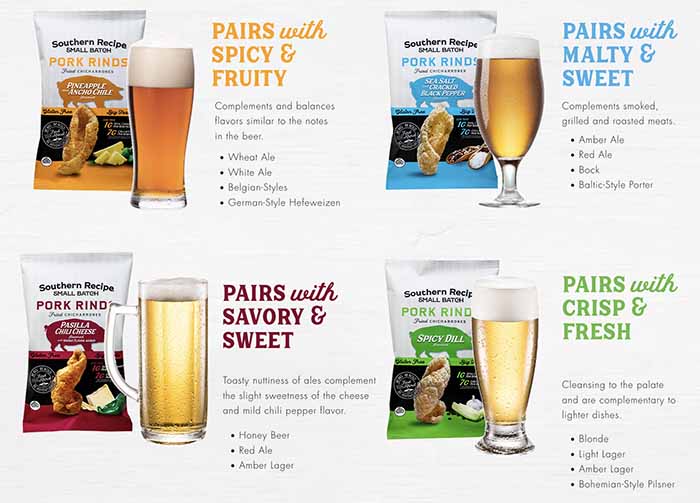
[9] Different flavors of pork rinds can be paired with different styles of beer. How’s that for a tasting party idea!
________________
*When fried with some of the fat attached to the skin, they are called cracklings.
†Pork rind pellets (also called pork skin pellets or chicharrones pellets) are a partially processed form of pork skin that hasn’t been fully cooked yet. They are used by commercial producers, restaurants and food service, and home cooks. They’re dehydrated pieces of pork skin that have been rendered and pressed, and can be stored at room temperature.
Raw pork skin is cleaned and stripped of excess fat, and cooked at a low temperature to remove moisture. It’s then cut and pressed into small, dense pieces which are dried until very hard. Most are meant to be deep-fried but some can be microwaved. Either way, the heat puffs them up to become light, crispy, and several times the size of the pellet (think popcorn kernels turning into popped corn).
CHECK OUT WHAT’S HAPPENING ON OUR HOME PAGE, THENIBBLE.COM.
|











